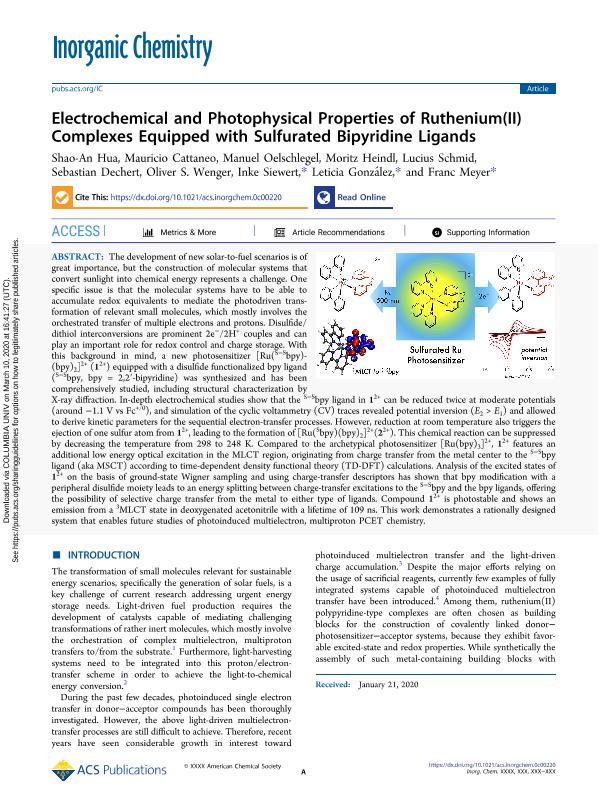Mostrar el registro sencillo del ítem
dc.contributor.author
Hua, Shao-An
dc.contributor.author
Cattaneo, Mauricio

dc.contributor.author
Oelschlegel, Manuel
dc.contributor.author
Heindl, Moritz
dc.contributor.author
Schmid, Lucius
dc.contributor.author
Dechert, Sebastian
dc.contributor.author
Wenger, Oliver S.
dc.contributor.author
Siewert, Inke
dc.contributor.author
González, Leticia
dc.contributor.author
Meyer, Franc
dc.date.available
2021-07-27T12:16:14Z
dc.date.issued
2020-03
dc.identifier.citation
Hua, Shao-An; Cattaneo, Mauricio; Oelschlegel, Manuel; Heindl, Moritz; Schmid, Lucius; et al.; Electrochemical and Photophysical Properties of Ruthenium(II) Complexes Equipped with Sulfurated Bipyridine Ligands; American Chemical Society; Inorganic Chemistry; 59; 7; 3-2020; 4972-4984
dc.identifier.issn
0020-1669
dc.identifier.uri
http://hdl.handle.net/11336/137012
dc.description.abstract
The development of new solar-to-fuel scenarios is of great importance, but the construction of molecular systems that convert sunlight into chemical energy represents a challenge. One specific issue is that the molecular systems have to be able to accumulate redox equivalents to mediate the photodriven transformation of relevant small molecules, which mostly involves the orchestrated transfer of multiple electrons and protons. Disulfide/dithiol interconversions are prominent 2e-/2H+ couples and can play an important role for redox control and charge storage. With this background in mind, a new photosensitizer [Ru(S-Sbpy)(bpy)2]2+ (12+) equipped with a disulfide functionalized bpy ligand (S-Sbpy, bpy = 2,2′-bipyridine) was synthesized and has been comprehensively studied, including structural characterization by X-ray diffraction. In-depth electrochemical studies show that the S-Sbpy ligand in 12+ can be reduced twice at moderate potentials (around-1.1 V vs Fc+/0), and simulation of the cyclic voltammetry (CV) traces revealed potential inversion (E2 > E1) and allowed to derive kinetic parameters for the sequential electron-transfer processes. However, reduction at room temperature also triggers the ejection of one sulfur atom from 12+, leading to the formation of [Ru(Sbpy)(bpy)2]2+(22+). This chemical reaction can be suppressed by decreasing the temperature from 298 to 248 K. Compared to the archetypical photosensitizer [Ru(bpy)3]2+, 12+ features an additional low energy optical excitation in the MLCT region, originating from charge transfer from the metal center to the S-Sbpy ligand (aka MSCT) according to time-dependent density functional theory (TD-DFT) calculations. Analysis of the excited states of 12+ on the basis of ground-state Wigner sampling and using charge-transfer descriptors has shown that bpy modification with a peripheral disulfide moiety leads to an energy splitting between charge-transfer excitations to the S-Sbpy and the bpy ligands, offering the possibility of selective charge transfer from the metal to either type of ligands. Compound 12+ is photostable and shows an emission from a 3MLCT state in deoxygenated acetonitrile with a lifetime of 109 ns. This work demonstrates a rationally designed system that enables future studies of photoinduced multielectron, multiproton PCET chemistry.
dc.format
application/pdf
dc.language.iso
eng
dc.publisher
American Chemical Society

dc.rights
info:eu-repo/semantics/openAccess
dc.rights.uri
https://creativecommons.org/licenses/by-nc-sa/2.5/ar/
dc.subject
ruthenium complexes
dc.subject
disulfide
dc.subject
electrochemistry
dc.subject
multiredox
dc.subject.classification
Físico-Química, Ciencia de los Polímeros, Electroquímica

dc.subject.classification
Ciencias Químicas

dc.subject.classification
CIENCIAS NATURALES Y EXACTAS

dc.title
Electrochemical and Photophysical Properties of Ruthenium(II) Complexes Equipped with Sulfurated Bipyridine Ligands
dc.type
info:eu-repo/semantics/article
dc.type
info:ar-repo/semantics/artículo
dc.type
info:eu-repo/semantics/publishedVersion
dc.date.updated
2021-07-26T15:16:20Z
dc.journal.volume
59
dc.journal.number
7
dc.journal.pagination
4972-4984
dc.journal.pais
Estados Unidos

dc.journal.ciudad
Washington
dc.description.fil
Fil: Hua, Shao-An. Universität Göttingen; Alemania
dc.description.fil
Fil: Cattaneo, Mauricio. Consejo Nacional de Investigaciones Científicas y Técnicas. Centro Científico Tecnológico Conicet - Tucumán. Instituto de Química del Noroeste. Universidad Nacional de Tucumán. Facultad de Bioquímica, Química y Farmacia. Instituto de Química del Noroeste; Argentina
dc.description.fil
Fil: Oelschlegel, Manuel. Universität Göttingen; Alemania
dc.description.fil
Fil: Heindl, Moritz. Universidad de Viena; Austria
dc.description.fil
Fil: Schmid, Lucius. Universidad de Basilea; Suiza
dc.description.fil
Fil: Dechert, Sebastian. Universität Göttingen; Alemania
dc.description.fil
Fil: Wenger, Oliver S.. Universidad de Basilea; Suiza
dc.description.fil
Fil: Siewert, Inke. Universität Göttingen; Alemania
dc.description.fil
Fil: González, Leticia. Universidad de Viena; Austria
dc.description.fil
Fil: Meyer, Franc. Universität Göttingen; Alemania
dc.journal.title
Inorganic Chemistry

dc.relation.alternativeid
info:eu-repo/semantics/altIdentifier/url/https://pubs.acs.org/doi/abs/10.1021/acs.inorgchem.0c00220
dc.relation.alternativeid
info:eu-repo/semantics/altIdentifier/doi/http://dx.doi.org/10.1021/acs.inorgchem.0c00220
Archivos asociados
